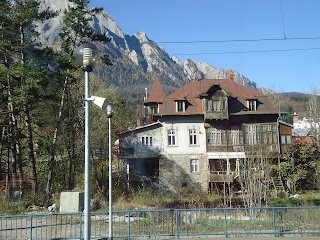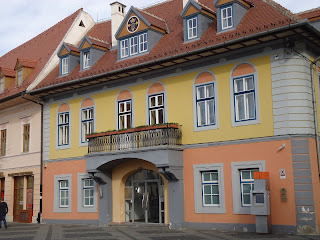Sibiu is close to the center of Romania, in Transylvania. The city, also known by its German name of Hermannstadt, was founded by German settlers in 1150. It grew as a center of craftsmen and of politics for two primary reasons: its centrally location near two major roads and its location relative to a pass through the Carpathian Mountains to the south. It is a beautiful small town - at least the historic center is! - and in 2007 was named a "European Capital of Culture", a designation of which the town is quite obviously proud.
The mountains came after about 2 hours of travelling (the total train trip was about 5 1/2 hours). I was engrossed looking at the scenery as we travelled, especially paralleling the mountains. Amanda slept most of the trip - she missed a lot of beauty!
I was a little surprised by the flatness of the plateau as we approached Sibiu...
We arrived in Sibiu on time, shortly after 3 in the afternoon. By 4:30 we had checked into our hotel, Villa Weidner, located right on the main square (and with a bank in the lower level), and were wandering about.
One of our first forays was into and up The Council Tower. There are 120 steps up and partway up I realized neither of us had brought our cameras! We continued on up, admiring both the inside of the tower and the views from the top.
Here is the tower as seen from the front of Villa Weidner after we got back down and I returned for the cameras...
One of the architectural features for which Sibiu is famous are these roof windows that look like eyes. Not all of them are painted to emphasize the look, but it is indeed interesting to look out upon them.
It didn't take Amanda long at all to find a new friend among one of the (very few) stray dogs in the historic center. "Red" obviously recognized Amanda's fondness for him, for he was often found waiting outside of doors we entered throughout our 3-day stay.
Soon it was too dark for pictures. We found a pleasant restaurant for supper and called it an early night...
We got going relatively early (for Amanda at least) Sunday and did our museum sightseeing that day (as they were all closed on Monday) in addition to simply walking around and enjoying the sights. The tower of the Evangelical Church is one of the focal points of the center city.
We visited the Pharmacy Museum, located in a building that dates from the mid-1500s, a contemporary of the period at which the first documented apothecary, "The Black Bear", was established in Sibiu. The museum is small, but contains implements, jars, and cabinets ranging from 16th to 19th centuries. It also includes a small exhibit on homeopathy, as the founder of homeopathy, Samuel Hahnemann, was a resident of Sibiu.
From there we went to the Ethnography museum (http://www.franzbinder.sibiu.ro/binder/eng/binder/Page2.html), an old-style collection of varied items from around the world, mostly collected in the 19th century. We were a little concerned about our plans for the day, however, since we had just finished 2 museums in less than one hour! (Both were very small!)
Things changed a bit when we went to the history museum. We spent an enjoyable 3 hours there, noticing the collections, learning a bit of Romanian history, and appreciating the building itself. (http://www.brukenthalmuseum.ro/istorie_en/index.html) Quoting from one of my guidebooks, "This building complex is considered to be the most important civilian building in the Gothic style in Transylvania..."
Above, Amanda enters the central courtyard of the museum. Below is a view within that courtyard toward the west tower. The museum includes much of the inner part of all parts of the building surrounding the courtyard, including this tower.
We poked about in a few shops in the evening and watched a Christmas tree go up in the town square. It may be the actual tree for the town, although it seems a bit early, but there were also movie cameras and people definitely dressed up being filmed, so not quite sure what was going on... But it was definitely pretty and fun to watch.
Monday morning I went off by myself for a bit. I wandered from the "upper town", where Amanda and I had stayed, to the "lower town". The lower town is outside the original city walls, which are visible in one of the pictures below. Mostly I was taking pictures of various architectural details...
The wall in the left part of the picture above is part of the original city wall, dating from the 14th century I believe.
The photo above is taken that Monday morning, in the shadow of the Evangelical Church. The moon is still up - see it just to the right of the top of the tree.
Above and below are the primary Orthodox Church in the city, just outside the historic center. Inside the art was tremendous - frescoes covering every surface. There was a small shop near it selling icons and religious materials. I had hopes they might have a small book of pictures from the inside of the church, but I was disappointed.
Some of the doorways leading from the main square (Piata Mare) lead to small alleys like this one below. Here the perspective is with my back to the small shop we visited and heading back toward the square...
These women are purchasing their lunch, I suppose, from one of many such store-front vendors that are common in Romania. I snapped their picture because of the traditional garb they are wearing.
And finally back to the top to take pictures out of each of the windows...
Below I have taken a picture of my feet as I am descending the oldest part of the tower. These stone steps date from the middle ages.
Once I returned to the ground it was time to collect our luggage and head to the train station. We caught the 3 pm train back to Bucharest. I took just a few pictures, but it soon became too dark. As you can see, the clouds were rolling in after our gorgeous weekend.








































Fantastic pictures of a fascinating town. Thanks for sharing! I love the roof eyes, and am wondering what it would take to have them added to our house.
ReplyDeleteI would like to note that those women are not wearing traditional Romanian garb, but rather gypsy outfits. Our traditional garb is a bit less flashy.
ReplyDeleteThanks for the clarification.
DeleteRomania este o tara minunata. Cand mai calatoriti pe aici si aveti nevoie de un mijloc eficient de transport va recomand in capitala serviciile de rent a car Bucuresti de la Goldenrent.
ReplyDelete